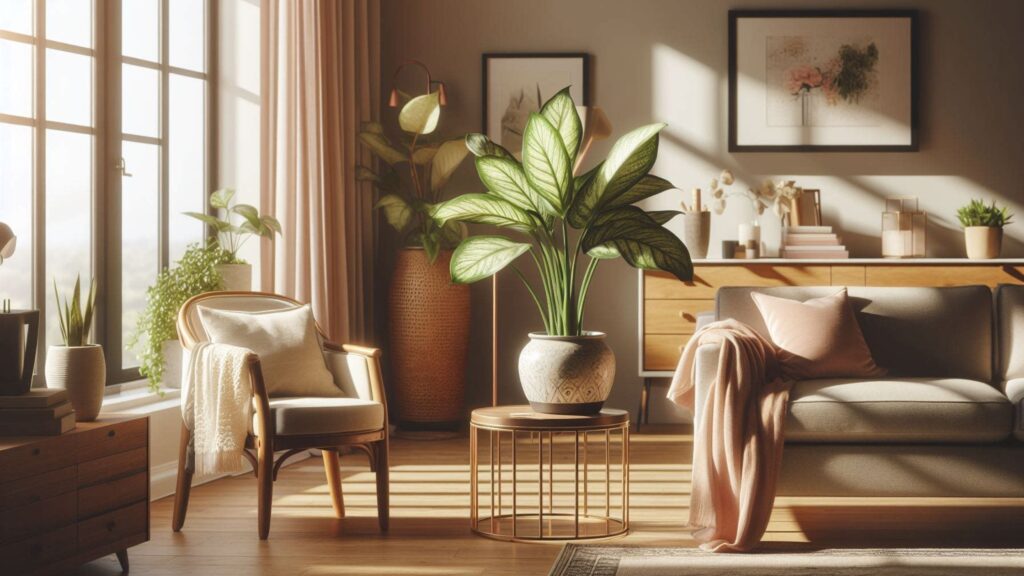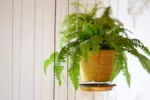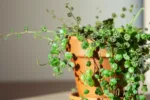Aglaonema, also referred to as Chinese evergreen, is a genus of extremely ornamental plants prized for its ability to thrive in indoor situations and for its vividly colored, patterned leaves. These slow-growing, evergreen perennials are members of the Araceae family of arum plants and are endemic to Southeast Asia.
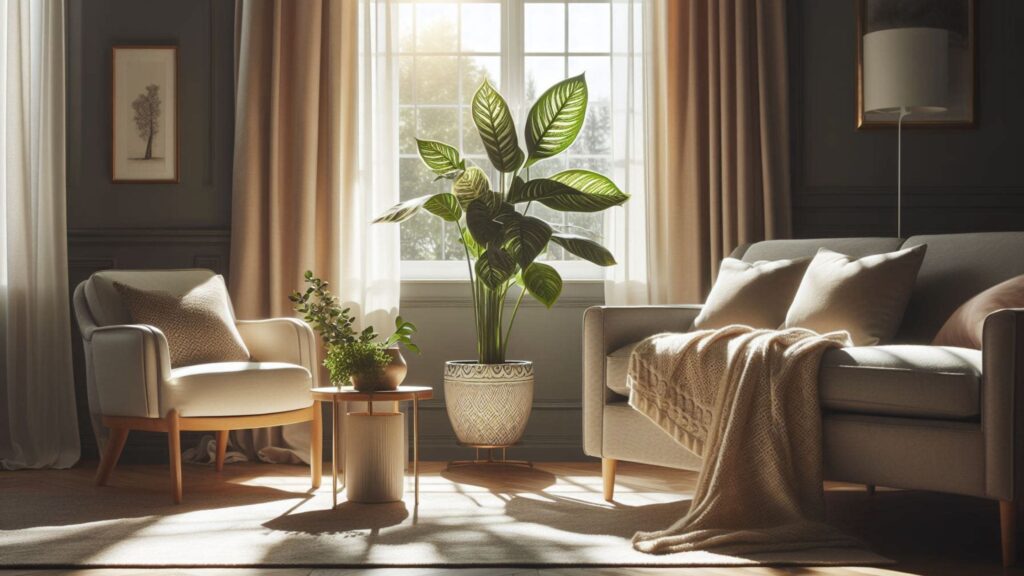
Types of Aglaonema Plant
Here are some of the most popular types of Aglaonema plants:
- Aglaonema Silver Bay
- Aglaonema Red Valentine
- Aglaonema Siam Aurora
- Aglaonema Sparkling Sarah
- Aglaonema Pink Dalmatian
- Aglaonema Crete
- Aglaonema Maria
- Aglaonema Golden Bay
Benefits of Aglaonema Plant
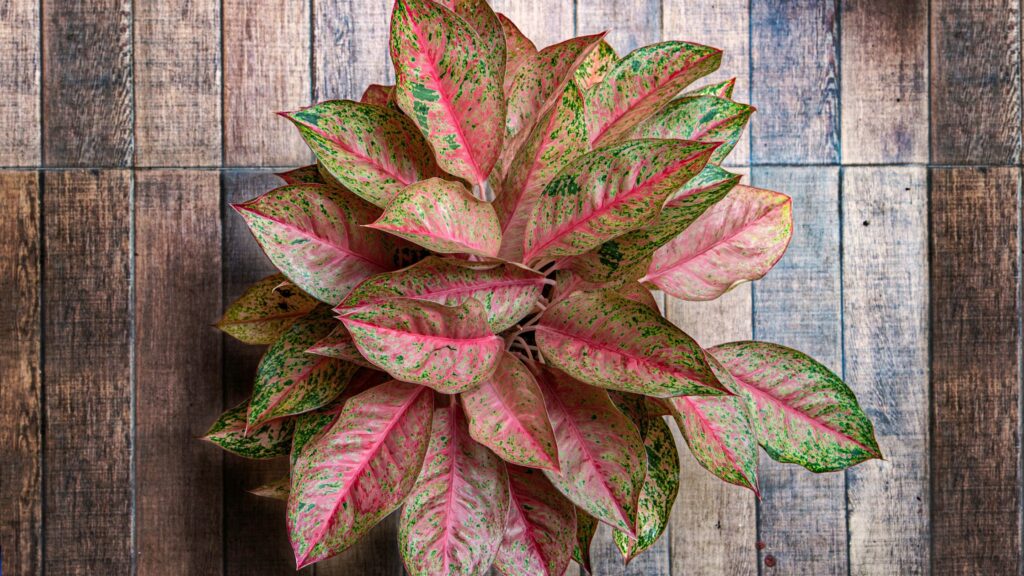
here are the benefits of an Aglaonema plant in simple words:
Cleans the air: Makes your home smell fresher by removing icky stuff like smoke and fumes from things like paint.
Easy to care for: It doesn’t need constant attention, even if you forget to water it sometimes.
Pretty leaves: Adds beauty to your room with colorful patterns and different shades of green, pink, and even silver!
Good luck charm: It brings positive vibes and maybe even some good fortune according to some beliefs.
Calms you down: Looking after a plant can help you relax and feel better.
Disadvantages of Aglaonema Plant
There are a few disadvantages to consider:
- Toxic: Aglaonema contains calcium oxalate crystals, which can cause irritation or harm if ingested by pets or children. The sap can also irritate the skin. Be cautious and wear gloves when handling the plant.
- Not fast growing: These plants don’t grow super quickly, so don’t expect them to take over your room overnight.
- Picky about water: Overwatering is a real danger for Aglaonemas. They can easily get root rot if the soil stays soggy. Learn the signs of underwatering and overwatering to keep your plant happy.
- Not flowering often: While Aglaonemas can flower, it’s not a common sight indoors. The flowers themselves aren’t very showy either.
- Limited light tolerance: While they can handle lower light levels, they won’t thrive in very dark corners.
Aglaonema Plant Care
Let’s dive into how to care for these lovely plants:
Light: Aglaonemas can tolerate a wide range of light levels, from bright indirect light to low light. They adapt well to less-than-ideal conditions. Place them near a window with filtered sunlight or in areas with artificial light
Watering: Keep the soil barely moist, but avoid letting it dry out completely. Water your Aglaonema when the top 1 inch (2.5 cm) of soil feels dry. Adjust the watering frequency based on the season: more in spring and summer, less in winter.
Temperature and Humidity: Maintain temperatures between 65°F and 80°F (18°C – 26°C). Aglaonemas appreciate medium to high humidity. Take into account spraying the foliage or utilizing a humidity tray.
Soil and Fertilization: Use a well-draining potting mix that is fertile, sandy, and humus-rich. Fertilize your Aglaonema monthly during the growing season with diluted houseplant fertilizer.
Common Issues: Limp and drooping leaves: Ensure proper watering and adjust light conditions. Yellowing leaves: Monitor soil moisture and avoid overwatering.
Propagation of Aglaonema Plant
Let’s dive into the world of Aglaonema propagation:
- Propagation by Cuttings:
- Tools Needed:
- Plant Shears: Sharp, clean shears are essential. If you don’t have plant shears, you can use new razor blades or sharpened kitchen scissors.
- Rooting Hormone: This substance significantly increases the chances of successful root formation.
- Steps:
- Select a healthy stem from your Aglaonema.
- Cut a section of the stem just below a leaf node (where leaves emerge).
- Add the rooting hormone to the cut end.
- Place the cutting in a potting mix that drains properly.
- Make sure the soil is always wet and give it some indirect light.
- In a few weeks, roots should develop, and you’ll have a new Aglaonema plant!
- Tools Needed:
- Propagation by Division:
- Tools Needed:
- Plant Shears (same as above)
- Steps:
- Gently remove the Aglaonema from its pot during repotting.
- Examine the root system.
- Make sure the plant has roots and stems in every region when you divide it into smaller pieces.
- Report the divided sections into separate containers.
- Water thoroughly and place them in a bright, indirect light spot.
- Tools Needed:
- Propagation by Seeds:
- While less common, you can collect seeds from mature Aglaonema flowers. However, this method requires patience and specific conditions.
Repotting of Aglaonema Plant
The following steps will help you navigate the process:
Choose the Right Time: Spring or early summer is the ideal time for repotting. During this period, your Aglaonema is actively growing, making it more resilient to the transition.
Select the Right Pot: Opt for a pot that is 3 to 4 inches wider than the current container. This gives the plant the freedom to flourish without being overly stressed. Make sure there are drainage holes in the new pot to avoid waterlogging.
Gently Remove the Plant: Carefully take your Aglaonema out of its current pot. If the roots are sticking to the sides, use a knife or spoon to loosen them. Inspect the root system and trim away any dead or damaged roots.
Prepare Fresh Soil: Line the new pot with fresh, well-draining soil. You can mix in some perlite for better aeration.
Place your Aglaonema in the center of the pot.
Replant and Water: Fill the gaps around the roots with more soil, ensuring the plant is at the same depth as before. To help the soil settle and promote the growth of roots, thoroughly water the area.
Aglaonema Plant Disease
Here are the most common diseases that affect Aglaonema plants:
Root Rot: Caused by overwatering or poor drainage. Roots become mushy, leaves yellow and wilt.
Leaf Spot: Fungal infection causing brown/black spots on leaves, leading to yellowing and dropping.
Powdery Mildew: Fungus creates white powdery growth on leaves, and thrives in humid conditions.
Bacterial Blight: Bacteria cause water-soaked lesions on leaves and stems, leading to wilting and slime.
Viral Diseases: Less common, result in mottled or distorted leaves, stunted growth, and general decline.
Aglaonema Plant Vastu
Here are some simple guidelines:
Placement: Place Aglaonema plants in the north, east, or northeast corners of your home or office for positive energy flow.
Avoid: Avoid placing them in the southwest corner, as this direction is associated with negativity in Vastu.
Care: Keep the plant healthy and vibrant to maintain positive energy. Trim dead leaves and ensure proper watering and light.
Aglaonema Plant for Pets
the Aglaonema plant, also known as the Chinese Evergreen, is not a good choice for a home with pets. All parts of the Aglaonema plant are toxic to pets, including cats, dogs, and horses, if ingested.
How to Buy Aglaonema Plant
Here’s a simple guide on how to buy an Aglaonema plant:
Choose a Reputable Seller: Look for nurseries, garden centers, or online stores known for selling healthy plants. Consult reviews or relatives or friends for suggestions.
Inspect the Plant: When selecting an Aglaonema plant, inspect it thoroughly. Look for vibrant, lush foliage with no signs of discoloration, spots, or pests. Avert plants that are withering or have yellowing leaves.
Examine the Roots: If at all feasible, carefully take the plant out of its pot and examine its roots. Healthy roots should be white or light-colored and firm, not mushy or brown.
Consider the Variety: Aglaonema plants come in various colors and patterns, so choose one that appeals to you. Popular varieties include Aglaonema ‘Silver Bay,’ ‘Red Valentine,’ and ‘Maria.
Size and Growth Stage: Decide on the size of the plant you prefer. You can buy small starter plants or larger, more mature specimens. Consider your space and how quickly you want the plant to grow.
Ask Questions: Don’t hesitate to ask the seller about the plant’s care requirements, such as watering, light, and humidity preferences. This information will help you provide the best conditions for your new plant.
Consider Online Purchases: If you can’t find Aglaonema plants locally, consider buying from reputable online sellers. Ensure they have positive reviews and offer healthy plants with secure packaging for shipping.
Check for Guarantees or Return Policies: Some sellers offer guarantees or return policies in case the plant doesn’t meet your expectations or arrives damaged. Before you make a purchase, familiarize yourself with these regulations.
Aglaonema Plant Names in Other Languages
Here are the names of Aglaonema plants in some other languages:
- Spanish: Planta de Aglaonema
- French: Plante d’Aglaonema
- German: Aglaonema-Pflanze
- Italian: Pianta di Aglaonema
- Portuguese: Planta de Aglaonema
- Dutch: Aglaonema plant
- Russian: Растение Аглаонема (Rasteniye Aglaonema)
- Japanese: アグラオネマの植物 (Aguraonema no shokubutsu)
- Chinese (Mandarin): 美玉叶 (Měi yù yè)
- Korean: 아글로네마 식물 (Ageullonema sigmul)
- Telugu: అగ్లానోమా చెట్టు (Aglaanoma Chettu)
- Hindi: अग्लोनेमा पौधा (Aglaonema Paudha)
- Kannada: ಅಗ್ಲೋನೆಮಾ ಸಸ್ಯ (Aglaonema Sasya)
- Tamil: அக்லானெமா காய்கறி (Aglaonema Kaayakari)
Conclusion
Aglaonema plant, it’s important to choose a healthy specimen from a reputable seller, ensuring vibrant foliage and firm roots. Consider factors such as variety, size, and growth stage to find the perfect plant for your space.
FAQs of Aglaonema Plant
1. What is an Aglaonema plant?
Ans: Aglaonema, also known as Chinese Evergreen, is a popular indoor plant prized for its attractive foliage. It belongs to the Araceae family and is native to the tropical and subtropical regions of Asia.
2. What are the types of Aglaonema plants?
Ans: There are numerous varieties of Aglaonema, each with its unique leaf patterns and colors. Some common types include Aglaonema Silver Bay, Aglaonema Red Valentine, Aglaonema Pink Dalmatian, and Aglaonema Emerald Beauty.
3. What are the benefits of Aglaonema plants?
Ans: Aglaonema plants are known for their air-purifying properties, helping to remove toxins from indoor air. They are low-maintenance, adaptable to various light conditions, and can thrive in low-light environments. Additionally, their vibrant foliage adds aesthetic appeal to indoor spaces.
4. What are the disadvantages of Aglaonema plants?
Ans: While generally easy to care for, Aglaonema plants can be toxic if ingested, so it’s essential to keep them out of reach of pets and children. Some individuals may also develop skin irritation upon contact with the plant’s sap.
5. How do I care for an Aglaonema plant?
Ans: Aglaonema plants prefer indirect light and well-draining soil. Water them moderately, allowing the soil to partially dry out between waterings. They thrive in temperatures between 65°F to 80°F (18°C to 27°C) and benefit from occasional fertilization during the growing season.
6. How do I propagate an Aglaonema plant?
Ans: Aglaonema plants can be propagated through stem cuttings or division. Stem cuttings should be taken from healthy, mature plants and rooted in water or moist potting mix. Division involves separating the plant into smaller sections, each with roots and stems, and replanting them in individual pots.
7. When should I repot my Aglaonema plant?
Ans: Repotting is typically done every 1-2 years or when the plant outgrows its current container. Choose a pot slightly larger than the current one and use a well-draining potting mix. Repotting is best done in spring or early summer when the plant is actively growing.
8. What diseases can affect Aglaonema plants?
Ans: Aglaonema plants are susceptible to fungal diseases such as root rot and leaf spot, especially in conditions of overwatering or poor air circulation. Proper watering practices and maintaining good hygiene can help prevent these issues.
9. Is there any Vastu significance associated with Aglaonema plants?
Ans: According to Vastu Shastra, Aglaonema plants are believed to bring positive energy and prosperity when placed in the home or workplace. They are often recommended for their ability to purify the air and promote harmony in the environment.

